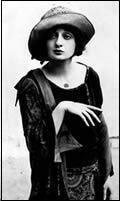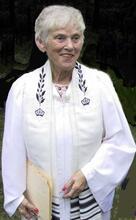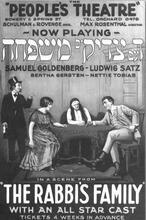Bertha Kalich
A distinguished performer, Bertha Kalich performed 125 roles in seven languages and became the first actress to make the transition from Yiddish theater to mainstream American drama in film, radio, and on stage. Kalich studied at the Lemberg Conservatory before joining the chorus of a local Polish theater at thirteen. She quickly became a star of Yiddish theater, performing in Budapest and Romania. She moved to the United States in 1894 and began pressing the vaudevillian Yiddish theater community for higher artistic standards, performing starring roles in new plays. In 1905, she performed in her first English language part, the title role in Fédora. She performed in both Yiddish and English roles on stage and silent movies until her retirement in 1931.
Known for her majestic bearing, great beauty, and fine diction, Bertha Kalich was the first female actor to make the transition from the Yiddish to the English stage. Critics called her the “Jewish Bernhardt” and she herself later estimated that she had played some 125 roles in seven languages during her long theatrical career. Kalich was one of the great stars of the golden age of the American Yiddish theater and, for a time, a leading light of mainstream American drama as well.
Early Life
Born Beylke Kalakh on May 17, 1874 (according to some sources, 1872 or 1875), in Lemberg, then Austria-Hungary, she was the only child of Solomon Kalakh, a brush manufacturer of modest means and an amateur violinist, and Babette (Halber) Kalakh, a dressmaker who made costumes for local theaters. A devotee of the opera, Babette Kalakh often took her daughter to performances, where the child fell in love with the stage.
Kalich studied music and drama in private schools and attended the Lemberg Conservatory. At age thirteen, she joined the chorus of the local Polish theater. She later performed in German as well. As a prima donna with the pioneering Yiddish theater group of Yankev Ber Gimpel, she played the title role in Avrom Goldfaden’s Shulamis. It was at that time that she adopted the name Bertha Kalich. (Other variations of her name include Kalisch and Kalish.) After performing in Budapest, Kalich returned to Lemberg to become a member of Goldfaden’s troupe, with which she traveled to Romania. There she learned Romanian in a matter of months and appeared in major roles with the state theater. She was such a success that anti-Semitic theatergoers, who had come with the intention of pelting her with onions, threw flowers instead.
In 1890, Kalich married Leopold Spachner. The couple had two children, Arthur, who died young, and Lillian.
Performance Career in the United States
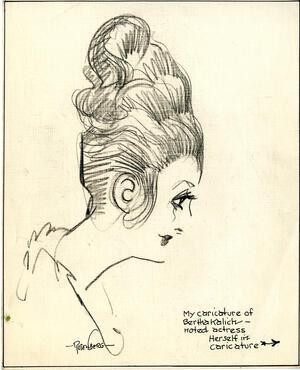
Caricature of Actress Bertha Kalich, by Manuel Rosenberg, illustrator, cartoonist, writer, editor, and publisher. From 1917-1930, Rosenberg was the chief artist for the Scripps-Howard chain of newspapers and the art editor of the Cincinnati Post. Courtesy of Anita Rosenberg.
Fearing a rumored assassination plot by jealous rivals, Kalich accepted an offer by Joseph Edelstein to come to New York to perform in his Thalia Theater. She arrived in the United States in 1894 (according to some sources, 1895 or 1896), appearing in Di Vilde Kenigin [The wild queen] and a Yiddish production of La Belle Hélène. She also took the roles of Shulamis, Juliette, and Desdemona.
In America, Kalich sought to emphasize her dramatic skills over her musical talents. She became known as a proponent of the movement for a Yiddish theater of higher artistic quality than was common at the time. Kalich’s performance in Leon Kobrin’s The East Side Ghetto won critical and popular acclaim. She distinguished herself especially in the works of playwright Jacob Gordin, whose didactic plays brought serious subjects to the Yiddish stage. In 1900, she starred as Freydenyu in the first production of Gordin’s God, Man and the Devil. Gordin wrote the role of Etty in The Kreutzer Sonata and the title role of his Sappho especially for Kalich. Over the years, Kalich played in many other Gordin roles. She also appeared in plays by Z. Libin, Dovid Pinsky, I.L. Peretz, and others.
For a time, Kalich was a partner with her husband and several others in the Thalia Theater. In addition to the Thalia, she appeared in the Romania Opera House, the Grand Theater, and elsewhere. For at least one season, Spachner rented the Windsor Theater and renamed it the Kalich Theater.
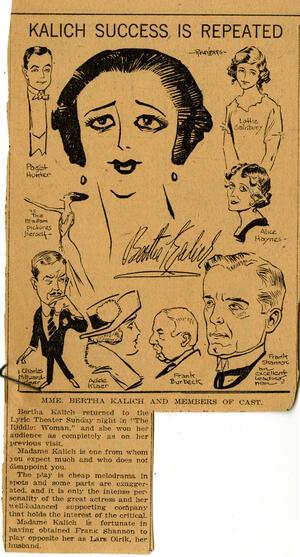
News clipping "Kalich Success is Repeated," from the Cincinnati Post, with drawings of actress Bertha Kalich and others by Manuel Rosenberg, illustrator, cartoonist, writer, editor, and publisher and from 1917 to 1930 chief artist for the Scripps-Howard chain of newspapers and art editor of the Cincinnati Post. Courtesy of Anita Rosenberg.
Kalich’s work on the Yiddish stage attracted the attention of prominent English-language theatrical producers. Her first English part was in the title role of Fédora, by Victorien Sardou, at the American Theater in 1905. Later that year, she signed with Harrison Grey Fiske and appeared in his production of Maurice Maeterlinck’s Monna Vanna at the Manhattan Theater. She labored for months with Minnie Maddern Fiske to correct her foreign accent, an effort in which she was largely successful. Over the next several years, Kalich acted in a number of plays for Fiske, both original works and adaptations of roles that she had created in Yiddish. By 1910, however, she was having trouble finding suitable roles in the light American theater for her more emotional and tragic style. She and Fiske parted company, and her career receded. Over the next decade, Kalich worked with Lee Shubert and Arthur Hopkins, and appeared in several early films. In 1923, she performed in Jitta’s Atonement, adapted by George Bernard Shaw from the work of Siegfried Trebitsch. Her other English roles in the 1920s included revivals of her earlier successes such as The Kreutzer Sonata.
Beginning in 1915, Kalich returned frequently to the Yiddish stage. There her success in the broader American theatrical world enhanced her prestige. Kalich appeared at the Second Avenue Theatre with Dovid Kessler, at Boris Tomashefsky’s National Theater, at the Irving Place Theatre, and at other New York theaters, as well as in Philadelphia and Chicago. She acted in plays by Rose Shomer and Miriam Shomer-Zunser, Esther Steinberg, Peretz Hirshbein, Moyshe Shor, and others.
Later Life and Legacy
By the late 1920s, Kalich’s health began to fail, and she gradually lost her sight. She announced her retirement in 1931, but took the stage occasionally thereafter, especially at several evenings mounted by the theatrical community especially for her benefit. She also played scenes from Goldfaden’s historical plays on The Forward Hour on radio station WEVD, rehearsing strenuously even for short parts. Her last appearance came on February 23, 1939, at a benefit for her at the Jolson Theater, when she recited the final scene of Louis Untermeyer’s poem “Heine’s Death.”
Bertha Kalich died on April 18, 1939. Only fifteen hundred people attended her funeral, considered a disappointing turnout. By that time, she seemed to be a relic of the theatrical past, with a manner too romantic and grand even for the Yiddish stage. Nevertheless, in the prime of her career at the beginning of the twentieth century, Kalich played an important role in efforts to improve the artistic standards of the Yiddish theater, whose status she also helped to raise with her success with English-speaking audiences.
AJYB 6 (1904–1905):192, 41:425.
Brynner, Witter. “Bertha Kalich: The Yiddish Actress.” Critic 47 (1905): 26.
Danziger, Adolph. “The Hebrew Theater.” Metropolitan Magazine 27 (December 1907): 348–359.
EJ; Lifson, David S. The Yiddish Theater in America (1965).
NAW; Obituaries. Jewish Daily Forward, April 19, 1939, 1 and NYTimes, April 19, 1939, 23.
Tog, April 19, 1939, 1.
Zylbercweig, Zalmen. Leksikon fun Yidishn Teater (1963), 4:2425–2458.


